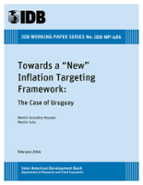Towards a "New" Inflation Targeting Framework: The Case of Uruguay
Date
Feb 2014
Using a dynamic stochastic general equilibrium model with financial frictions, this paper evaluates the effects of a rule that incorporates not only the interest rate but also the legal reserve requirements as instruments of monetary policy. It is found that reserve requirements can be used to achieve the Central Bank's inflation objectives. The use of this instrument, however, produces a real appreciation of the Uruguayan peso. When the Central Bank uses the monetary policy rate as an instrument, the effect of an increase in reserve requirements is to contribute to reducing the negative impact on consumption, investment and output. Nevertheless, the quantitative results in terms of inflation reduction are rather poor. The policy rate becomes more effective in reducing inflation when the reserve requirement instrument is solely directed at achieving financial stability. The paper's main policy conclusion is that a well-targeted non-conventional policy instrument can help to effectively control inflation.



